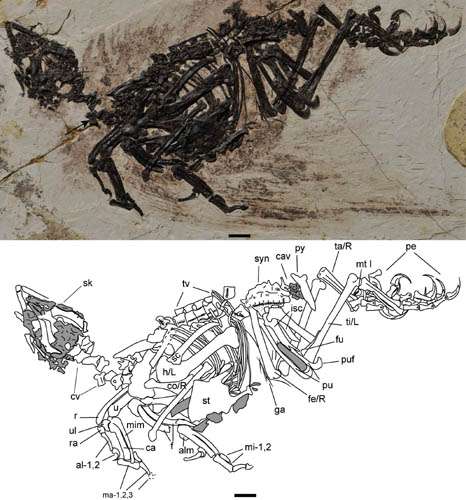New Enantiornithine bird with scansorial adaptations discovered from the Lower Cretaceous of China

Enantiornithes, an extinct group of primitive birds, were the most abundant and diverse avialans of the Mesozoic. The abundance of enantiornithine fossils, and in particular the well-preserved nearly complete skeletons known from the Lower Cretaceous of China, has made it possible for researchers to address questions such as how well enantiornithines could fly, whether they were primarily terrestrial or arboreal, and why they were so successful during the Cretaceous.
In a paper published in the latest issue of Journal of Vertebrate Paleontology, paleontologists from Institute of Vertebrate Paleontology and Paleoanthropology (IVPP) of the Chinese Academy of Sciences described a new enantiornithine bird, Fortunguavis xiaotaizicus, from the Lower Cretaceous lacustrine deposits of the Jiufotang Formation in northeastern China. Features of this new species suggested that it was scansorial, an ecology previously unknown for enantiornithine birds, further increasing the known diversity of body plans in Early Cretaceous enantiornithines.
The new bird is represented by a single, largely complete, articulated specimen. The complete fusion of the proximal carpometacarpus, tibiotarsus, and proximal tarsometatarsus indicates that the individual was fully mature at the time of death, and that, unlike enantiornithine taxa known from juvenile or subadult specimens (e.g., Liaoxiornis, Bohaiornis, and Rapaxavis), the preserved morphologies are likely to represent the adult form and are not subject to further ontogenetic change.
The new specimen was recovered from the Lower Cretaceous Jiufotang Formation near Xiaotaizi Village in Lamadong Town, Jianchang County, Liaoning Province, northeastern China. The same locality has yielded the toothless basal ornithuromorph Zhongjianornis, two specimens of the lizard Yabeinosaurus, material of the fish Lycoptera, and unpublished dinosaur and pterosaur specimens.
The new species is pigeon-sized and has a unique combination of features. The unique morphology of the pectoral girdle distinguishes it from other enantiornithine birds. Compared with other enantiornithines from the Early Cretaceous, it is very robust. It has unique foot morphology with metatarsal II much shorter than metatarsal IV, robust pedal digits, and strongly recurved pedal unguals. "Although recurved unguals characterize Enantiornithes, the extreme curvature present in Fortunguavis suggests scansorial specialization in this species", said lead author Dr. WANG Min of the IVPP.
More information: Min Wang, Jingmai K. O'Connor & Zhonghe Zhoua. "A new robust enantiornithine bird from the Lower Cretaceous of China with scansorial adaptations." Journal of Vertebrate Paleontology, Volume 34, Issue 3, 2014. DOI: 10.1080/02724634.2013.812101
Journal information: Journal of Vertebrate Paleontology
Provided by Chinese Academy of Sciences





















